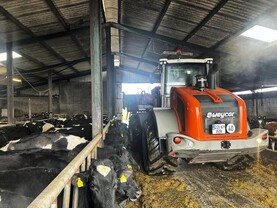With cattle housed for winter management, farmers will now have silage pits opened. Once pits are in use, the face of the clamp needs to be properly managed to avoid silage from spoiling.
Outlined are five tips to managing the clamp after it is opened so the amount of waste silage is kept to a minimum.
1. Keep the shear grab sharp for a clean cut
The shear grab performs two functions when in use. As well as cutting blocks of silage, it also seals the face of the pit to stop air from entering.
Sealing the pit face is arguably the more important role, as this stops silage from spoiling. Therefore, make sure the shear grab is sharpened regularly and replace any broken blades.
2. Keep the pit face even
When cutting silage from the pit, it is important to work from top to bottom, then move across the pit face.
This keeps the pit face even and reduces the surface area in contact with air, keeping spoilage to a minimum.
Always start cutting fresh silage where the last grab was taken on the previous day. Do not be tempted to cut more blocks from the top, or middle, of the pit just because it is better silage.
This only increases the amount of spoilage, as the silage at the bottom of the pit face is exposed to air for a longer time period before being used.
3. Work across the face as quickly as possible
Ideally, work from one side of the pit to the other over the course of a week. This will keep the pit face fresh.
If it is taking longer than a week to work from one side to the other, the clamp face is more likely to heat, turn black or grow mould. To move across the face of the clamp at a faster rate, cut shallower blocks of silage.
4. Remove waste
Remove spoiled silage from the top and sides of the pit before cutting fresh blocks for feeding. Mould on fodder can cause pregnant cows to abort and increases the risk of listeriosis.
5. Removing the cover safely
Think about safety when removing the pit cover. When possible, try to remove the cover during daylight. This may mean pulling back the cover on weekends for part-time farmers.
Plastic can be slippery, especially after rain or heavy frost, so always work with caution. Make sure tyres are cleared to reduce the risk or tripping. Also, wear gloves, as old tyres can have wire exposed.
The rolled cover can hold water, which increases the weight, so puncture the plastic occasionally to let water drain off.
If you are removing the cover in the dark, having good external lights is a must for safety. Finally, always use a ladder that is properly secured to climb on the pit.
Read more
Lakeland holds October milk price
Watch: housing for 2020-born calves on Thrive demo farm
With cattle housed for winter management, farmers will now have silage pits opened. Once pits are in use, the face of the clamp needs to be properly managed to avoid silage from spoiling.
Outlined are five tips to managing the clamp after it is opened so the amount of waste silage is kept to a minimum.
1. Keep the shear grab sharp for a clean cut
The shear grab performs two functions when in use. As well as cutting blocks of silage, it also seals the face of the pit to stop air from entering.
Sealing the pit face is arguably the more important role, as this stops silage from spoiling. Therefore, make sure the shear grab is sharpened regularly and replace any broken blades.
2. Keep the pit face even
When cutting silage from the pit, it is important to work from top to bottom, then move across the pit face.
This keeps the pit face even and reduces the surface area in contact with air, keeping spoilage to a minimum.
Always start cutting fresh silage where the last grab was taken on the previous day. Do not be tempted to cut more blocks from the top, or middle, of the pit just because it is better silage.
This only increases the amount of spoilage, as the silage at the bottom of the pit face is exposed to air for a longer time period before being used.
3. Work across the face as quickly as possible
Ideally, work from one side of the pit to the other over the course of a week. This will keep the pit face fresh.
If it is taking longer than a week to work from one side to the other, the clamp face is more likely to heat, turn black or grow mould. To move across the face of the clamp at a faster rate, cut shallower blocks of silage.
4. Remove waste
Remove spoiled silage from the top and sides of the pit before cutting fresh blocks for feeding. Mould on fodder can cause pregnant cows to abort and increases the risk of listeriosis.
5. Removing the cover safely
Think about safety when removing the pit cover. When possible, try to remove the cover during daylight. This may mean pulling back the cover on weekends for part-time farmers.
Plastic can be slippery, especially after rain or heavy frost, so always work with caution. Make sure tyres are cleared to reduce the risk or tripping. Also, wear gloves, as old tyres can have wire exposed.
The rolled cover can hold water, which increases the weight, so puncture the plastic occasionally to let water drain off.
If you are removing the cover in the dark, having good external lights is a must for safety. Finally, always use a ladder that is properly secured to climb on the pit.
Read more
Lakeland holds October milk price
Watch: housing for 2020-born calves on Thrive demo farm






 This is a subscriber-only article
This is a subscriber-only article










SHARING OPTIONS: